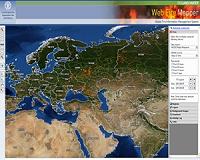 |
Bonn, Germany (SPX) Sep 09, 2010 What works on a small scale also works on a large scale. For the last several years, a helicopter-mounted measuring instrument developed by the German Aerospace Center (Deutsches Zentrum fur Luft- und Raumfahrt; DLR) has been hard at work detecting methane leaks from natural gas pipelines. From 2014, a similar instrument will be used on a German/French satellite orbiting Earth at an altitude of 650 kilometres. The climate mission Merlin (Methane Remote Sensing Lidar Mission) will track down the greenhouse gas methane around the globe. This Franco-German collaborative venture has one principal objective - to obtain more and higher-precision data on methane emissions. Methane and carbon dioxide both cause global warming, although the impact of methane is 25 times more powerful than of carbon dioxide. Now, at a time when there is much discussion about mankind being directly responsible for the rise in the emission of greenhouse gases, methane emission levels already far outstrip carbon dioxide. Since pre-industrial times, the amount of methane in the atmosphere has more than doubled, whereas the growth in carbon dioxide levels during the same period has been 'only' thirty percent. Alongside carbon dioxide, methane is one of those gases for which the Kyoto Protocol stipulates that cuts must be achieved.
Tried and tested measuring principle The instrument, developed jointly by DLR, ADLARES GmbH and E.ON Ruhrgas AG, transmits pulses of light towards Earth, and then receives the radiation that is reflected back from Earth's surface, again in pulse form. Whenever one of these pulses encounters methane, its signal strength is reduced and the instrument detects this reduction. This is how the LIDAR on a helicopter is able to detect methane leaks from natural gas pipelines. Now, instead of testing a mere eight kilometres of pipeline per day, the CHARM system (CH4 Airborne Remote Monitoring) is able to inspect 50 kilometres an hour. "The measurement principle has already been tried and tested," emphasises Peter Schaadt of the DLR Space Agency. Instead of inspecting natural gas pipelines, the space-borne instrument will seek out both natural methane sources and those due to human activities at a speed of 25,000 kilometres an hour. It will send its laser beam to and from Earth 50 times a second. "With the measured values, we can produce a world map showing atmospheric methane concentrations and also highlighting regional differences," says Gerhard Ehret from the DLR Institute of Atmospheric Physics.
Conclusions drawn about methane sources The data that the German/French climate satellite will gather from orbit will enable scientists in both countries to draw conclusions about the various different sources of methane emissions. What is the impact of rising levels of energy production? What are the implications when tracts of permafrost release methane as they start to thaw? Above all, what are the implications for our climate? "The data obtained are so precise that you could even, for example, use the satellite to monitor compliance with conventions such as the Kyoto Protocol," says Dr Ehret. For three years, the satellite equipped with this methane LIDAR system will scan the atmosphere for methane content, day and night, and even in the presence of light cloud cover. The costs of this mission are expected to amount to Euro 120 million, to be shared between the two project partners, Germany and France. Merlin is a joint mission by DLR and the French space agency CNES. DLR is developing and building the methane LIDAR instrument. France is providing the satellite platform and mission control.
Share This Article With Planet Earth
Related Links German Aerospace Center (DLR) Earth Observation News - Suppiliers, Technology and Application
 NASA Satellite Data Aids Ability To Detect Global Fire Hotspots
NASA Satellite Data Aids Ability To Detect Global Fire HotspotsWashington DC (SPX) Sep 08, 2010 In the midst of a difficult fire season in many parts of the world, the United Nations' (UN) Food and Agriculture Organization has launched a new online fire detection system that will help firefighters and natural hazards managers improve response time and resource management. The Global Fire Information Management System (GFIMS) delivers fire data from an imaging sensor aboard NASA's Ter ... read more |
|
| The content herein, unless otherwise known to be public domain, are Copyright 1995-2010 - SpaceDaily. AFP and UPI Wire Stories are copyright Agence France-Presse and United Press International. ESA Portal Reports are copyright European Space Agency. All NASA sourced material is public domain. Additional copyrights may apply in whole or part to other bona fide parties. Advertising does not imply endorsement,agreement or approval of any opinions, statements or information provided by SpaceDaily on any Web page published or hosted by SpaceDaily. Privacy Statement |